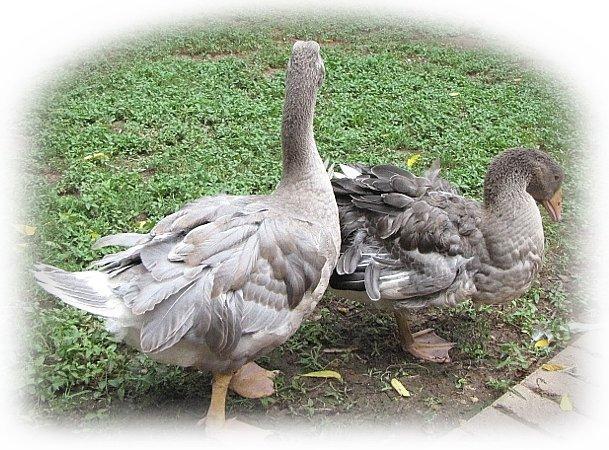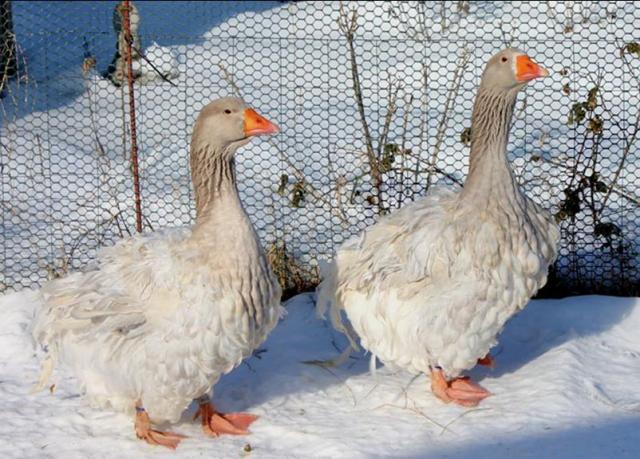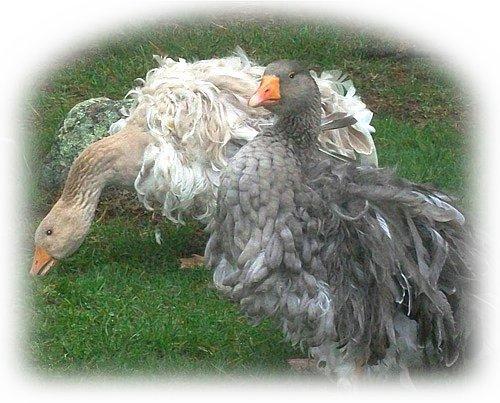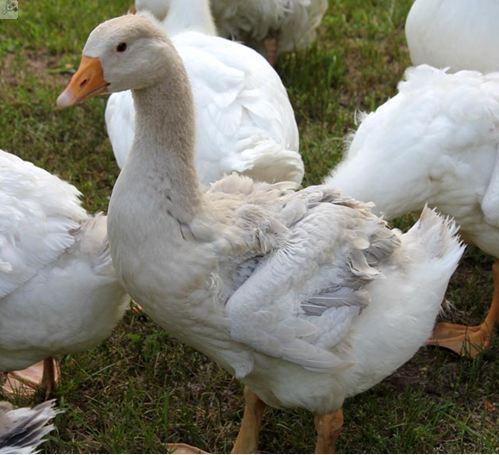goosesdesLandes
In the Brooder
- Apr 22, 2019
- 5
- 3
- 11
DEFININING BLUE, LAVANDER, LILAC AND CREAM IN SEBASTOPOLS.
Hi All
Further to a previous paper on genetics for colour and pattern I have looked at the genetics controlling the more unusual colours of Sebastopols that are being developed in the USA. As I have said previously I may be incorrect but I hope this work continues to add to the overall knowledge base. Once again I am indebted to my friends on the Sebastopol Geese Lovers Forum for their continued support and kind permission to use photographs of their lovely birds. In particular my thanks to Vicky, Christine, Kim and Barb.
Pete
There certainly seems to be some confusion around defining what Lilacs, Lavanders and Creams look like! There's been some debate on another forum of what a Lavander is!!! This is an area that URGENTLY needs clarification. As more breeders produce Sebastopols in colours of Blue, Lilac, Lavander and Cream then these will need defining. The visual colour of the goose is an expression of the interaction of its genes that are responsible for colour. Its appearance is called its Phenotype. The genetic code for the interaction of the genes is called its Genotype. It is here that lies the potential for great confusion and to resolve this dilemma the bird's Phenotype must correspond with its Genotype
Some maintain that a Lavander is the result of interaction between Blue and Buff genes while other opinions are that lavander is the interaction of Blue genes only. To clarify the matter I wrote to Dave Holderresad and recieved the following reply;
"Lavender is the interaction of 2 different loci; Blue is the result of a single locus and Gray is the foundation color."
The statement is slightly ambiguous but I will try to explain it. However this is MY interpretation and I may be incorrect. Basically the genes for colour are found in pairs. An allele is simply a single variation of this gene and occupies a certain position (or locus) on that gene. In this case we are discussing the Blue gene (often coded as Bl) and this is referred to as autosomal gene which exhibitis partial dominance. Put more simply it is not a sex linked gene and the incomplete dominance means it can produce two levels of Blue colour.
The statement was; "Lavender is the interaction of 2 different loci; Blue is the result of a single locus and Gray is the foundation color."
So interpreting this statement it is saying that a Blue results from a single allele at one position (locus). Therefore the foundation colour of Grey has one partially dominant allele for Blue and its genotype would be written as; Bl, bl. The single partially dominant allele (Bl - written as a capital to represent dominance) changes the grey goose to a visual Blue. It is said to be Heterozygous for the Blue gene (meaning it has 2 different alleles - Bl and bl).

A Blue and a Grey Sebastopol owned by Barb (Sebastopol Geese Lovers Forum)
Now if the grey goose inherited a Blue gene from each parent then it would be Homozygous for the Blue gene and its genetic code for blue could be written as Bl, Bl. It has a pair of Blue genes. One allele occupying a locus on a gene from the father and one allele occupying a locus on a gene inherited from the mother. As the bird has a pair of Blue genes then the full visual effect of the Blue gene is realised and the bird appears as an even lighter blue.
Think of it as; if one blue gene changes a Grey bird to a visual Blue, then the effect of an additional Blue gene changes a Blue bird to an even lighter colour sometimes refered to as a Silver (or is this Lavander)!
There's no easy way to explain it and as yet it is not certain what the genotype for a Lavender is. Is it the result of the bird being homozygous for the Blue gene or does the statement from Holderreads mean that Lavander is the result of Blue and Buff genes from different loci. Unfortunately the statement is not clear enough for me to make a decision and I have asked for further clarity. However in personal communication with another goose breeder they confirmed that Holderreads had e-mailed the following statement; "Matings of Blue x Blue or Blue x Lavender typically result in offspring of both Blue and Lavender. Lavender x Lavender results in Lavender offspring." There is no mention that Lavanders are the result of intereaction with Blue and Buff genes.
SILVERS OR ?LAVANDERS
So having established that there are two levels of Blue what on earth do people call the bird with the palest colour (which is homozygous for Blue). Is this a Silver or is this the elusive Lavander??? If a breeder mates 2 'pure' Blue Sebastopols together then this breeding should produce the following;
Silver male x 1 (visually lighter blue)
Blue males x 2
Grey male x1
Silver female x 1 (visually lighter blue)
Blue females x 2
Grey female x1
So my question is has anybody done this cross and produced these lighter blue birds? If so; what are they called???
If these pale blue birds which are (homozygous for the Blue gene) are then 'test' mated together then they will also only produce the same pale blue birds. So IF we are calling these pale Blue birds Lavanders then;
Lavander x Lavander = 100% Lavander

A pair of Lavander Sebastopols. Bred by Dave Holderread and owned by Cottage Rose Sebastopols.
BUFF
The Buff gene is known as a recessive sex linked gene. This means that it is carried on the Z sex chromosome. In order to show visually all the birds Z chromosomes must carry a recessive form (allele) of this gene. So in the case of a female whose genotype for sex is ZW then only one recessive gene that is linked to the Z chromosome is required for the effect to be expressed visually. In the case of a male with two Z chromosomes then both genes must carry the recessive gene for the effect to show visually. If only one of the Z chromosomes carries a recessive gene then the male will carry (or be split for) the recessive gene in its genotype but its phenotype remains the same. The following matings show how to produce Buffs.
Grey male x Buff female = 100% Grey but all Males are split for Buff.
Grey male (split for Buff) x Grey female = 25% Grey males (split for buff), 25% Grey males, 25% Grey females, 25% Buff females.
Grey male (split for Buff) x Buff female = 25% Grey males (split for buff), 25% Buff males, 25% Grey females, 25% Buff females.
Buff male x Grey female = 50% Grey males (split for Buff) and 50% Buff females.
Buff male x Buff female = 100% Buff

A Buff daughter with Grey mother owned by Zanter (Sebastopol Geese Lovers Forum)
LILACS
Using the information already discussed about the Blue and Buff genes we can use this information to predict the appearance of the Goose when these genes interact together. All that needs to be remembers is that Blue is a partially dominant gene and Buff is a sex linked recessive gene. Therefore;
Blue male x Buff female = 50% Blue and 50% Grey (all males are split for Buff)
Buff male x Blue female = 25% Blue males (split for Buff), 25% Grey males (split for Buff), 25% Buff female, 25% Lilac female.
Blue male (split for Buff) x Buff female = 25% Blue, 25% Grey, 25% Buff, 25% Lilac (in equal sex ratios) (all males are split Buff).
Lilac male x Buff female = 50% Lilacs and Buffs (all in equal sex ratios)
Lilac male x Lilac female = 25% Buff, 50% Lilac, 25% Cream (all in equal sex ratios)
The final mating of Lilac to Lilac gives the parents genes the opporunity to interact and the result is 25% of the offspring have 2 Blue genes. They have a double dose of the Blue gene (Homozygous) but also have the Buff gene. If we recall the information on the Lavander it is a lighter shade of Blue due to being homozygous for the Blue gene. In effect the goose is a Lavander combined with the visual effect of Buff.

A rare Lilac Sebastopol owned by Cottage Rose Sebastopols.
CREAM
We have seen that a Cream should appear visually as an even lighter shade of Lilac due to the presence of the additional Blue gene. Unfortunately I have not seen a Cream Goose or even a picture but would imagine it is a very attractive pale mushroom colour. If the Creams are used in the breeding programme then the following matings will produce Creams;
Lilac male x Lilac female = 25% Buff, 50% Lilac, 25% Cream (all in equal sex ratios)
Cream male x Lilac female = 50% Lilacs and 50% Cream
Lilac male x Cream female = 50% Lilacs and 50% Cream
Cream male x cream female = 100% Cream
Lavander male (split for Buff) x Lavander female = 25% Lavander males (split for Buff), 25% Lavander males, 25% Lavander females, 25% Cream females
Cream male x Blue female = 25% Blue males (split for Buff), 25% Lavander males (split for Buff), 25% Lilac females, 25% Cream females
SUMMARY
From the information above it would be my proposals to classify the Sebastopol colours that are a result of interaction between the Blue and Buff gene(s) as follows;
Blue - a visually Blue bird which has a single Blue gene (heterozygous for Blue).
Lavander - a visually pale Blue bird which has a pair of Blue genes (homozygous for Blue)
Lilac Male - a visually Buff bird with Blue overlay. Has a single Blue gene (heterozygous for Blue) and a pair of Buff genes (homozygous for Buff).
Lilac female - a visually Buff bird with Blue overlay. Has a single Blue gene (heterozygous for Blue) and a single Buff gene (heterozygous for Buff).
Cream Male - a visually Buff bird with Pale Blue overlay. Has a pair of Blue genes (homozygous for Blue) and a pair of Buff genes (homozygous for Buff).
Cream Female - a visually Buff bird with Pale Blue overlay. Has a pair of Blue genes (homozygous for Blue) and a single Buff gene (heterozygous for Buff).
Although some readers may find it complex to understand and first I hope this report clarifies some of the more unusual Sebastopol colours and enables others to forward their breeding programmes in these very attractive colours.
Super interesting - thank you! Do you ever sell fertilized eggs? We are in France and looking to purchase Sebastopol eggs to hatch out! Thank you









